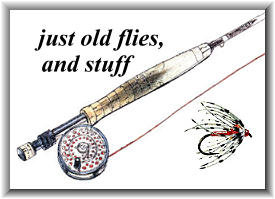"To George M. La Branche, of New York City, goes all
credit for the popular Pink Lady.
Mr. La Branche's father's favorite fly, and consequently
his, was a Queen of the Waters. Once when preparing
for a trip, and failing to obtain his desired patterns,
the clerk sold him some flies called "King of the Waters."
A King is not unlike the Queen, except it has a scarlet
body, instead of orange. In drying some after using, the
red dye in the body faded to a pink.
This pink bodied fly, tied in Mr. La Branche's pattern with
upright wings and a tial, in appearance not unlike the
imago of the Mayfly, is the Pink Lady.
Mr. La Branche tells of it in his fascinating book,
The Dry Fly and Fast Water, written in
1914, rated as one of the best American trout books. He
was one of the organizers of the Angler's Club of New
York, in 1905, and one of the incorporating directors of
the National Association of Scientific Angling Clubs, in
1909.
Mr. La Branche describes his fly as - Wings, medium
starling or duck. Body, pale pink floss, ribbed with
flat gold tinsel. Legs, ginger or light reddish brown
hackle. Tail, three whisks of same."
The version shown here is the palmered, dry version
of the Pink Lady.
Quoting Dick Surett's Trout and Salmon Fly Index,
"A historic party of four anglers, Roy A. Thompson, Colonel
Ambrose Monell, Dr. Orrin Summers, and George LaBranche worked
on dry fly patterns on the Upsalquitch in New Brunswich around
1910. By 1924 the flies were proven and well tested and were
presented in LaBranche's book the Dry Fly and the Salmon.
Many anglers were doubtful that the dry would work on salmon, but this
party of four fished in New Brunswick when the fish were plentiful
and more cooperative than today."
Credits: Text from Fly Patterns
and Their Origins by Harold Hinsdill Smedley,
Published by Westshore Publications. Fly photo from
Forgotten Flies. We appreciate
use permission.
|



